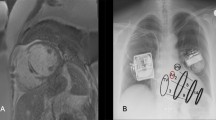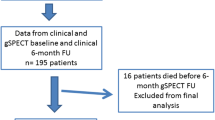Abstract
Background
We evaluated the effect of cardiac resynchronization therapy (CRT) on septal perfusion and thickening at 6 months post implantation assessed on Tc99m-MIBI Gated myocardial perfusion SPECT (GMPS).We also studied the association of change in septal perfusion and thickening with primary outcome defined as at least one [improvement in ≥1NYHA class, left ventricular ejection fraction (LVEF) by ≥ 5%, reduction of end-systolic volume (ESV) by ≥ 15%, and improvement ≥ 5 points in Minnesota living with heart failure questionnaire (MLHFQ)].
Method
One hundred and five patients underwent clinical and GMPS evaluation before and at 6 months post CRT.
Result
Post CRT there was significant improvement in mean normalized septal perfusion uptake and in septal thickening (P value = 0.001, both). There was no significant relation between improvement in septal perfusion and primary outcome. However, improvement in septal thickening was statistically significant with favorable primary outcome (P = 0.001).There was no significant correlation between improvement of septal perfusion and improvement in LVEF, reduction in End diastolic volume (EDV), ESV, and Left ventricular Dyssynchrony (LVD). But, there was significant correlation between improvement of septal thickening and these parameters.
Conclusion
Improvement in septal thickening was associated with reverse remodeling, improvement in LVEF, and reduction of LVD.







Similar content being viewed by others
Abbreviations
- CRT:
-
Cardiac resynchronization therapy
- HF:
-
Heart failure
- LBBB:
-
Left bundle branch block
- LVEF:
-
Left ventricular ejection fraction
- GMPS:
-
Gated myocardial perfusion SPECT
- LVD:
-
Left ventricular dyssynchrony
- MLHFQ:
-
Minnesota living with heart failure questionnaire
- PSD:
-
Phase standard deviation
- RBBB:
-
Right bundle branch block
- OSEM:
-
Ordered subset expectation maximization
References
Auricchio A, Stellbrink C, Sack S, Block M, Vogt J, Bakker P, Pacing Therapies in Congestive Heart Failure (PATH-CHF) Study Group, et al. Long-term clinical effect of hemodynamically optimized cardiac resynchronization therapy in patients with heart failure and ventricular conduction delay. J Am Coll Cardiol 2002;39(12):2026–33.
Cazeau S, Leclercq C, Lavergne T, Walker S, Varma C, Linde C, Multisite Stimulation in Cardiomyopathies (MUSTIC) Study Investigators, et al. Effects of multisite biventricular pacing in patients with heart failure and intraventricular conduction delay. N Engl J Med 2001;344(12):873–80.
Abraham WT, Fisher WG, Smith AL, Delurgio DB, Leon AR, Loh E, MIRACLE Study Group, Multicenter InSync Randomized Clinical Evaluation, et al. Cardiac resynchronization in chronic heart failure. NEngl J Med 2002;346(24):1845–53.
Young JB, Abraham WT, Smith AL, Leon AR, Lieberman R, Wilkoff B, Multicenter InSync ICD Randomized Clinical Evaluation (MIRACLE ICD) Trial Investigators, et al. Combined cardiac resynchronization and implantable cardioversion defibrillation in advanced chronic heart failure: the MIRACLE ICD Trial. JAMA 2003;289(20):2685–94.
Bristow MR, Saxon LA, Boehmer J, Krueger S, Kass DA, De Marco T, Comparison of Medical Therapy, Pacing, and Defibrillation in Heart Failure (COMPANION) Investigators, et al. Cardiac-resynchronization therapy with or without an implantable defibrillator in advanced chronic heart failure. N Engl J Med 2004;350(21):2140–50.
Cleland JG, Daubert JC, Erdmann E, Freemantle N, Gras D, Kappenberger L, Cardiac Resynchronization-Heart Failure (CARE-HF) Study Investigators, et al. The effect of cardiac resynchronization on morbidity and mortality in heart failure. N Engl J Med 2005;352(15):1539–49.
Lozano I, Bocchiardo M, Achtelik M, Gaita F, Trappe HJ, Daoud E, VENTAK CHF/CONTAK CD Investigators Study Group, et al. Impact of biventricular pacing on mortality in a randomized crossover study of patients with heart failure and ventricular arrhythmias. PacingClinElectrophysiol 2000;23(11 Pt 2):1711–2.
Cooke CD, Garcia EV, Cullom SJ, Faber TL, Pettigrew RI. Determining the accuracy of calculating systolic wall thickening using a fast fourier transform approximation: A simulation study based on canine and patient data. J Nucl Med 1994;35:1185–92.
Zhou W, Garcia EV. Nuclear image-guided approaches for cardiac resynchronization therapy. Curr Cardiol Rep 2016;18:7.
Claridge S, Chen Z, Jackson T, Sammut E, Sohal M, Behar J, et al. Current concepts relating coronary flow, myocardial perfusion and metabolism in left bundle branch block and cardiac resynchronisation therapy. Int J Cardiol 2015;181:65–72.
Vernooy K, Verbeek XA, Peschar M, Crijns HJ, Arts T, Cornelussen RN, et al. Left bundle branch block induces ventricular remodelling and functional septal hypoperfusion. Eur Heart J 2005;26(1):91–8.
Nowak B, Stellbrink C, Schaefer WM, Sinha AM, Breithardt OA, Kaiser HJ, et al. Comparison of regional myocardial blood flow and perfusion in dilated cardiomyopathy and left bundle branch block: role of wall thickening. J Nucl Med 2004;45(3):414–8.
Higgins JP, Williams G, Nagel JS, Higgins JA. Left bundle-branch block artifact on single photon emission computed tomography with technetiumTc99m (Tc-99m) agents: mechanisms and a method to decrease false-positive interpretations. Am Heart J 2006;152:619–26.
Ogano M, Iwasaki YK, Tanabe J, Takagi H, Umemoto T, Hayashi M, et al. Cardiac resynchronization therapy restored ventricular septal myocardial perfusion and enhanced ventricular remodeling in patients with nonischemic cardiomyopathy presenting with left bundle branch block. Heart Rhythm 2014;11(5):836–41.
Brandão SC, Nishioka SA, Giorgi MC, Chen J, Abe R, Martinelli Filho M, et al. Cardiac resynchronization therapy evaluated by myocardial scintigraphy with 99mTc-MIBI: changes in left ventricular uptake, dyssynchrony, and function. Eur J Nucl Med Mol Imaging 2009;36(6):986–96.
Nowak B, Stellbrink C, Sinha AM, Kaiser HJ, Reinartz P, Koos R, et al. Effects of cardiac resynchronization therapy on myocardial blood flow measured by oxygen-15 water positron emission tomography in idiopathic-dilated cardiomyopathy and left bundle branch block. Am J Cardiol 2004;93:496–9.
Nielsen JC, Bøttcher M, Jensen HK, Nielsen TT, Pedersen AK, Mortensen PT. Regional myocardial perfusion during chronic biventricular pacing and after acute change of the pacing mode in patients with congestive heart failure and bundle branch block treated with an atrioventricular sequential biventricular pacemaker. Eur J Heart Fail 2003;5:179–86.
Neri G, Zanco P, Zanon F, Buchberger R. Effect of biventricular pacing on metabolism and perfusion in patients affected by dilated cardiomyopathy and left bundle branch block: Evaluation by positron emission tomography. Europace 2003;5:111–5.
Lindner O, Vogt J, Kammeier A, Wielepp P, Holzinger J, Baller D, et al. Effect of cardiac resynchronization therapy on global and regional oxygen consumption and myocardial blood flow in patients with nonischaemic and ischaemic cardiomyopathy. Eur Heart J 2005;26:70–6.
Vernooy K, Cornelussen RN, Verbeek XA, Vanagt WY, van Hunnik A, Kuiper M, et al. Cardiac resynchronization therapy cures dyssynchronopathy in canine left bundle-branch block hearts. Eur Heart J 2007;28(17):2148–55.
Ogano M, Iwasaki YK, Tanabe J, Takagi H, Umemoto T, Hayashi M, et al. Restoration of ventricular septal hypoperfusion by cardiac resynchronization therapy in patients with permanent right ventricular pacing. Int J Cardiol 2016;224:353–9.
Author information
Authors and Affiliations
Corresponding author
Ethics declarations
Disclosure
Dr Garcia receives royalties from the sale of the Emory Cardiac Toolbox used in this research. The terms of this arrangement have been reviewed and approved by Emory University in accordance with its COI practice. He is also a consultant for Syntermed Inc and GE Healthcare. There are no other relationships with industry.
Additional information
Publisher's Note
Springer Nature remains neutral with regard to jurisdictional claims in published maps and institutional affiliations.
The authors of this article have provided a PowerPoint file, available for download at SpringerLink, which summarises the contents of the paper and is free for re-use at meetings and presentations. Search for the article DOI on SpringerLink.com.
Electronic supplementary material
Below is the link to the electronic supplementary material.
Rights and permissions
About this article
Cite this article
Patel, C., Kalaivani, M., Karthikeyan, G. et al. Effect of cardiac resynchronization therapy on septal perfusion and septal thickening: Association with left ventricular function, reverse remodelling and dyssynchrony. J. Nucl. Cardiol. 27, 1274–1284 (2020). https://doi.org/10.1007/s12350-019-01704-0
Received:
Accepted:
Published:
Issue Date:
DOI: https://doi.org/10.1007/s12350-019-01704-0




